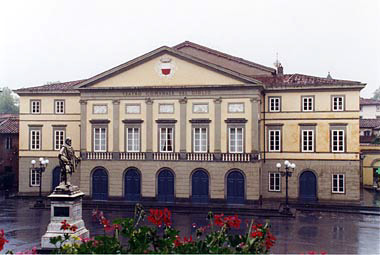
Cavalleria Rusticana
libretto by Giovanni Targioni-Tozzetti and Guido Menasci, from Giovanni Verga’s short story
music by Pietro Mascagni
Santuzza Raffaella Angeletti / Elena Pankratova
Turiddu Mickael Spadaccini / Javier Palacios
Alfio Leo An / Anooshah Golesorkhi
Mamma Lucia Kamelia Kader / Irene Bottaro
Lola Ozge Kalelioglu / Chiara Mattioli
I Pagliacci
libretto and music by Ruggero Leoncavallo
Nedda Raffaella Angeletti / Esther Andaloro
Canio Ernesto Grisales / Mickael Spadaccini
Tonio Leo An / Anooshah Golesorkhi
Peppe David Ferri Durà / Giulio Pelligra
Silvio Marcello Rosiello / Alessandro Luongo
Contadini Antonio Della Santa, Nicola Vocaturo
with Elena Croce
and with Valentina Escobar e Valentina Pardini
Conductor Jonathan Webb
Maestro of the Choir Marco Bargagna
Maestro of the Children’s Choir Marisol Carballo
direction Alessio Pizzech
Notes Maurizio Costanzo
Scenery Michele Ricciarini
Costumes Cristina Aceti
Lights Valerio Alfieri
Orchestra e Coro della Toscana
Coro voci bianche Fondazione Teatro Goldoni
New staging Teatro Goldoni di Livorno
In collaboration with Teatro del Giglio di Lucca, Teatro Verdi di Pisa, Teatro Comunale Luciano Pavarotti di Modena
Theatre del Giglio
The Theatre del Giglio is one of the most important points of reference in the cultural life of Tuscany. It hosts a season for concerts, prose, and also dance since the year 2000. Its activity and history is principally linked to the opera season which is presently under the direction of Maestro Elio Boncompagni.
Inside the theatre, there is a specialised library where videos and a rich collection of LP’s and audio CD’s are conserved in addition to an archive containing several documents, such as concert programmes from different Italian theatres, booklets, etc which makes it particularly interesting for researchers and enthusiasts. The theatre activities are also noted in the training development field. The Città Lirica Opera Studio project in collaboration with the Teatro CEL in Livorno and the Teatro Verdi in Pisa, each year, organise a workshop for training development and specialisation for professions involved in theatre, and conclude with the putting on of a performance.
Another very important initiative is, without a doubt, the “Youth Observatory” which is a workshop on theatre reviews. Here some students from the high schools in Lucca write up reviews on the performances featuring in the theatre programme at the Giglio.
Details:
by car: park outside San Pietro Gate, enter the gate and take via S. Girolamo until Piazza del Giglio
shuttle Bus from the paid parking area in Viale Carducci
From the railway station go along Viale regina Margherita until San Pietro Gate, then take via S. Girolamo until Piazza del Giglio
Tel. 0583/46531
Ticket Office: Tel. 0583/467521 biglietteria@teatrodelgiglio.it
Press Office: Fax 0583/490317 ufficiostampa@teatrodelgiglio.it
Administration: Fax 0583/465339
Library: biblioteca@teatrodelgiglio.it
Azienda Teatro del Giglio
The Theatre del Giglio has a prestigious historical background. Lucca, an autonomous city-state until the Napolionic period, has always been a very lively cultural centre. There were already two active theatre halls in the 17th century, but it still wasn’t enough to satisfy the needs of its inhabitants. The Teatro Pubblico was inaugurated in 1675, after a citizens board had studied the possibility of converting the old Gesuati convent for such a purpose. The building was destroyed by a fire in 1688 and was reconstructed four years later according to the original plans of Francesco Buonamici. When the Republic was brought down in 1799, the theatre went through a decadent period which lasted until 1817 when construction work was started on the new building under Giovanni Lazzarini’s plans. The new theatre was inaugurated in 1819; its name, “Teatro del Giglio”, was chosen by Maria Luisa di Borbone, the Sovreign of Lucca,.
Since then, the stage of the Teatro del Giglio has become one of the most important in Italy. In 1985 it was given the title “Teatro di Tradizione” which is an honour bestowed on very few great, historic, Italian theatres.





